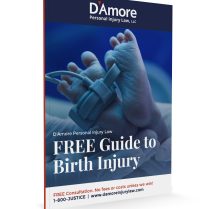D'Amore Personal Injury Law, LLC
Serious Injury Lawyers Proudly Serving
Baltimore, Annapolis, & Washington, D.C.
Cerebral Palsy
Our birth injury attorneys know how to win your child’s case.
What causes Cerebral Palsy?
Cerebral palsy is a group of lifelong conditions caused by injuries to the brain from abnormal development or sometimes, damage to the developing brain. Cerebral palsy either develops before (fetal distress), during (birth trauma), or soon after birth, potentially affecting the child’s intellect, vision, sensation, movement, coordination, and posture. The child may also be at risk for seizures.
In around 85%-90% of cases, cerebral palsy is caused by brain damage before or during birth, this is known as ‘congenital cerebral palsy.’
In rarer cases, cerebral palsy occurs in newborns more than 28 days after birth. This is referred to as ‘acquired cerebral palsy’ and is usually caused by head injuries or serious infections such as meningitis.
Cerebral Palsy Due to Lack of Oxygen at Birth
When a baby does not receive adequate oxygen during or just after birth, asphyxia results leading to permanent brain injury.
Asphyxia is a dangerous condition and in many cases, is preventable. It can lead to devastating lifelong complications such as cerebral palsy, or even death.
Complications that can cause birth asphyxia can include:
A prolonged or traumatic delivery:
A prolonged or traumatic birth puts the baby at risk for developing cerebral palsy by depriving the baby of oxygen during birth. Through a variety of mechanisms, traumatic or prolonged births increase the risks of oxygen deprivation. These can include incorrect use of forceps or a vacuum extractor leading to injury to the umbilical cord or direct injury to the baby’s brain.
An Umbilical Cord Prolapse:
The umbilical cord carries oxygen from the mother to the baby. An umbilical cord prolapse occurs when the umbilical cord is trapped between the baby’s head and the birth canal resulting in an umbilical cord compression, or pinching of the cord, reducing oxygen delivery. A cord prolapse must be treated immediately to avoid prolonged oxygen deprivation leading to asphyxia and permanent brain injury.
An Umbilical Cord Prolapse:
Shoulder dystocia occurs when a baby’s shoulder gets “stuck” against the mother’s pelvic bone as the baby passes through the birth canal. In this condition, the baby’s head is delivered but his chest is still compressed so he cannot breathe on his own. For a variety of reasons, including umbilical cord compression, shoulder dystocia may lead to decreased oxygen delivery to the baby. Shoulder dystocia must be quickly recognized and properly managed before permanent brain injury from lack of oxygen occurs.
A Breech Birth:
A breech position is when the baby is positioned bottom or feet first, instead of head first, into the birth canal. A breech presentation makes vaginal birth difficult as the baby does not pass through the birth canal normally. This can result in the baby being “stuck” leading to prolonged delivery and increased risk of asphyxia. The majority of babies in the breech position are delivered via a planned cesarean section. If the baby is delivered vaginally and the delivery is not properly managed, a breech birth can result in injuries such as brachial plexus palsy or the devastating complication of cerebral palsy from lack of oxygen to the baby.
Maternal Shock in Pregnancy or Birth:
Maternal shock is a decreased blood pressure in the mother. It can occur from blood loss during birth or a severe type of infection known as sepsis. If unrecognized and untreated, the decreased maternal blood pressure can injure the mother and lead to inadequate oxygen delivery to the baby resulting in fetal asphyxia.
In most of the above instances, if a pregnancy or birth is properly managed, birth asphyxia leading to cerebral palsy can be prevented. Cerebral palsy can be an emotionally, physically, and financially devastating life-long condition.
Learn more about what to do after a Birth Injury in our FREE guide.

Compensation can help fund a better quality of life
In most of the above instances, if a pregnancy or birth is properly managed, birth asphyxia leading to cerebral palsy can be prevented. Cerebral palsy can be an emotionally, physically, and financially devastating life-long condition.
A successful injury lawsuit can provide your family with compensation for your child’s life-long suffering and fund the ongoing costs of medical treatment, medications, surgery, specialty care, home adaptations, and other long-term expenses you will experience from these preventable complications.
Clients Lives We've Helped Rebuild
Her daughter suffered a birth injury
" Fantastic Attorney "
— Kieara D.
F.A.Q.
WHO CONDUCTS RESEARCH FOR MY CHILD’S CEREBRAL PALSY CASE?
All research will be done by our birth injury lawyers and their consulting medical experts. Because the parents of the injured child have the most intimate knowledge of the facts surrounding the injury, it is beneficial for you to work closely with our lawyers in the beginning of the legal process in order to fully evaluate all of the relevant facts.
HOW LONG DOES A CEREBRAL PALSY LAWSUIT TAKE?
The length of a Cerebral Palsy lawsuit varies widely depending on the jurisdiction in which the case must be brought. In general, these cases may take several years to win.
HOW MUCH WILL IT COST TO HIRE A BIRTH INJURY LAWYER TO HELP MY CHILD?
Nothing.
There is no cost to you unless we win. If the case is successfully resolved, the costs of the lawsuit are repaid from the recovery.
MY CHILD WAS DIAGNOSED WITH CEREBRAL PALSY, WHAT DO I DO NEXT?
1. Learn all you can about your child’s diagnosis
2. Follow the advice of your child’s pediatrician and other medical providers
3. Document Everything
4. Take Photographs
5. Talk with an experienced birth injury attorney
RELATED ARTICLES
FREE Case Consultation
Fill out the form below and we will contact you.
Or, give us a call at

